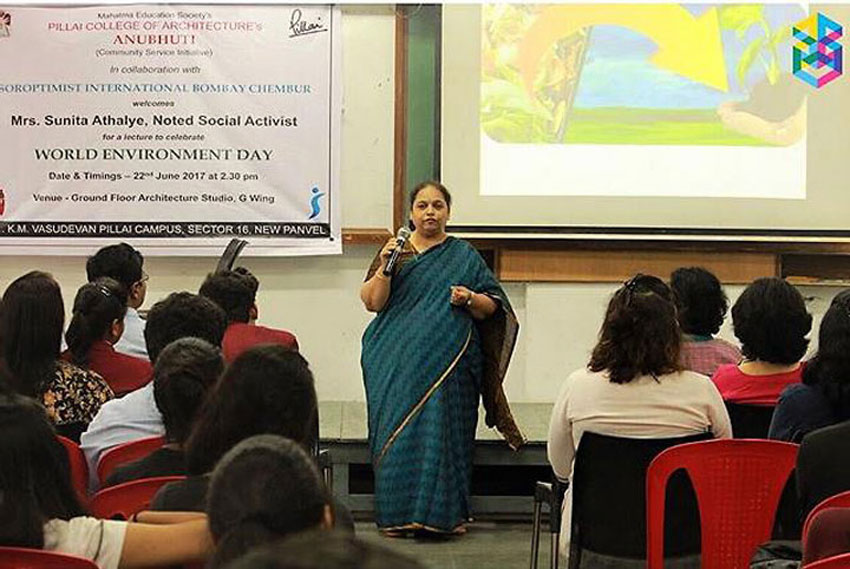World Environment Day was hosted by Anubhuti, (A social initiative by students of Pillai college of Architecture) in collaboration with SIBC (Soroptimist International Bombay Chembur). The programme consisted of a talk by respected Sunita Athlye. It was held on the 22nd June, 2017 in the first year studio at PiCA.

The honourable chief guest Mrs. Sunita Athlye arrived by 2:45 p.m. and the event started at 2:50 p.m. The event started by welcoming our dignitaries which included Madam Sunitha Athalye who is a master degree holder in Science and Textile Chemistry and has various accreditations in the field. She was also a faculty at Rachna Sansad, Nirmala Niketan, and at the extra mural department of Mumbai University.
Other guests of honour were Madam Daphne Pillai, the Co-founder of Pillai Group of institutions & founder member of SIBC; Dr. Arif N. Merchant, Principal of the Pillai College of Architecture; and Madam Yvette Lee, member of SIBC; faculty and students of Dr. Pillai Global Academy; and students of biotech department from our campus.
Mrs. Athlye was then invited to speak a few words on Garbage to Garden (G2G), her brainchild, is an in-situ bio conversion of biodegradable waste and an initiative to convert garbage in gardens directly. She talked about converting garbage to a useful compost; basically manure.
Biodegradable waste also known as Green Garbage can be converted to manure which consists of 80-60% of household waste. Insitu is basically Bio-conversion of Biodegradable waste. It is manure used as a soil mixture for plants which is different from vermi-compost.
This method does not include any chemical & can be adapted by anyone.
Requirements for the procedure include:
Soil, manure, water, greenhouse material, brick band, sand, grit, net, coal Biodegradable waste or mixtures of biodegradable wastes are to be used.
Biodegradable wastes include wet yard waste, dung, wastes of fruits and vegetables, dried leaves, coconut shells, dry grass, twigs, brooms and tea leaves, saw dust, coco peat, rice husk, gunny bags, wood shavings, coir sheet, and sugarcane waste.
Bio-culture that is a mixture of bacteria and yeast can also be used. The same compost can act for the next plant as well. Pots to be used can be of plastic, metal, concrete, vintage pot, etc.
Technique or Method:
Drain Holes (Layering): Drain holes should be made at the bottom of the pots to let out the foul smell due to usage of garbage (pests and mosquitoes).
Liner: It is a filter which is made out of greenhouse material or net so that the compost doesn’t get washed away.
Drainage Layer: It is mainly made of brick bat, coal or sand it does not hold the water.
Filler: It is a very important layer as the plant anchors its roots in this layer. It is clayey and sticky.
This layer can be made from rice husk, sugarcane waste, coco- peat, old clothes, mattress etc. for support.
- Tear the bag & remove as much soil as possible.
- Place the plant and spread the roots and start with the garbage.
- After four inches of garbage, sprinkle the culture & alternate it with garbage and fill it till the top.
- Water the plant properly. (Water seeps through all the layers.)
- Keep the plant in a shaded area for 15 days and do not add more garbage to it.
- Daily watering is required. After a certain period buds appear, the plant accepts the new surroundings.
- Then again start adding garbage the garbage need not be processed.
Merits of the procedure:
- It is simple and safe
- Light weight (structural advantages for balconies and cantilevers).
- Light weight and flexible.
- Does not attract any pest.
- No foul smell.
- No re-potting required.
- No over grown roots.
- Gives all nutrients and minerals.
- Eco friendly (waste management at grass level).
- Speeds growth of the plant.
- Flowers with vivid colour.
- Fruits are richer.
- Produces dark, crumbly and earthy substances that can anchor plants well.
Principals of Garbage Management were stated as ‘Reuse, recover, and recycle’.
Pictures of plants grown by the orator herself were also shown amongst which were as follows:
Fruit bearing plants
Lemon tree, chikoo, mandarins, pomegranates, guavas, grape fruit, drumstick, star fruit, mulberry, custard apple, fig, musk melon, lemon drop, wild berry, banana, tomato, curry leaves, sugarcane, cardamom, alocassia, insulin, betel leaves, all spices, nut meg.
Flowering plants
Champa, hibiscus, indica and mandar, Brahma kamal clematis, shevanti, euphorbia, calliandra, bleeding heart, heliconia, passion flower, sadaphuli, shrimp, mogra, malati, kamini, cuphea, cat tail, football lily.
Decorative plants
Decorative banana and bamboo plants, philodendron, crondons, poinsettia, esculanta
Application of such plants
As enhancers Terraces Concealers or screening Balconies Semi- shade areas Entrances, Porches
After the talk, questions from audience were patiently answered. The event ended around 3:45 p.m. It was a very successful event people got information which they could try or implement in their day to day lives. This event brought its audiences closer to the nature on the occasion of world environment day.
These methods could be implemented by Anubhuti in Kombal Tekdi as a part of the long term goal.

